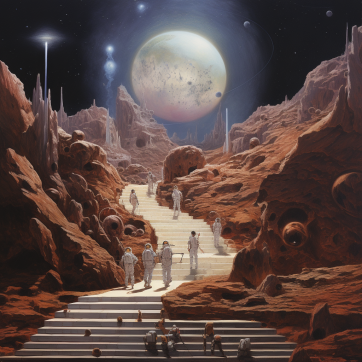The Raelian Movement, or Raelism, emerged in the 1970s, rooted in the experiences of Claude Vorilhon, who later adopted the name Rael. This modern religious movement is underpinned by Rael’s claim of encounters with extraterrestrial entities, who he asserts bestowed upon him profound insights into the genesis and purpose of human life on Earth.
Core Beliefs and Principles
Central to Raelian philosophy are teachings said to have been communicated to Vorilhon by these otherworldly beings, known as the Elohim. Raelians posit that life on Earth, rather than evolving or being divinely created in a traditional sense, was scientifically engineered by the Elohim. These advanced extraterrestrial architects are believed to have fashioned humans in their likeness. This perspective offers a reinterpretation of the word “Elohim,” which is found in the Hebrew Bible and is traditionally translated as “God.” In the Raelian context, it is understood as a reference to “those who came from the sky.”
The messages Vorilhon claims to have received in 1973 go beyond mere origins. He states that the Elohim tasked him with the mission of enlightening humanity about its cosmic roots. Furthermore, he was instructed to prepare for the Elohim’s return by constructing an embassy.
Embracing global unity and peace is also foundational to Raelian philosophy. The movement champions the vision of a united world government, a necessary precursor, they believe, to the return of the Elohim. In “Intelligent Design: Message from the Designers,” Rael articulates this vision, noting, “Humanity is now ready to understand its origins, and the arrival of the Elohim in their embassy will seal this newfound awareness.”
An interesting aspect of Raelism is its enthusiastic embrace of scientific advancement, especially in areas like genetics and nanotechnology. Raelians hold the conviction that science will ultimately unlock the secrets of immortality.
Additionally, Raelism is distinguished by its progressive views on sexuality, seeing it as a natural, celebratory aspect of human experience. Their practices emphasize the positive and spiritual dimensions of sensual and sexual expression.
Practices and Symbols
Raelians observe several annual festivals that commemorate the significant encounters Vorilhon claimed to have had with the Elohim. Symbolism is essential in the movement, with one of their emblems intertwining the Swastika and the Star of David, representing infinity and the eternal nature of the Elohim. Recognizing the adverse reactions to the Swastika in many cultures, due to its association with Nazism, the movement has, in some contexts, substituted the Swastika with a swirling galaxy design.
Controversies and Criticisms
Over its history, the Raelian Movement has not been without controversy. A significant media stir occurred in 2002 when Clonaid, a company linked to Raelism, announced that it had successfully produced the first human clone. This declaration drew intense media scrutiny, with the broader scientific community expressing substantial skepticism. No conclusive evidence was ever provided to substantiate the claim.
The movement’s narratives about extraterrestrial life, human cloning, and its redefinition of religious stories have naturally sparked challenges and skepticism, both from traditional religious groups and secular quarters. Susan J. Palmer, in her book “Aliens Adored: Rael’s UFO Religion,” delves into these controversies, suggesting that while Raelism challenges mainstream beliefs, it also reflects broader societal fascinations with extraterrestrials and the potentialities of science.
The Raelian Movement offers a distinctive blend of modern preoccupations, like genetics and the possibility of extraterrestrial life, with spiritual quests for meaning and connection. As with any religious movement, while it provides its adherents with a meaningful worldview, it also prompts skepticism and dialogue from wider society. Raelism’s existence and persistence underscore the diverse ways humanity grapples with timeless questions about origins, purpose, and destiny in an ever-evolving cultural and scientific landscape.
